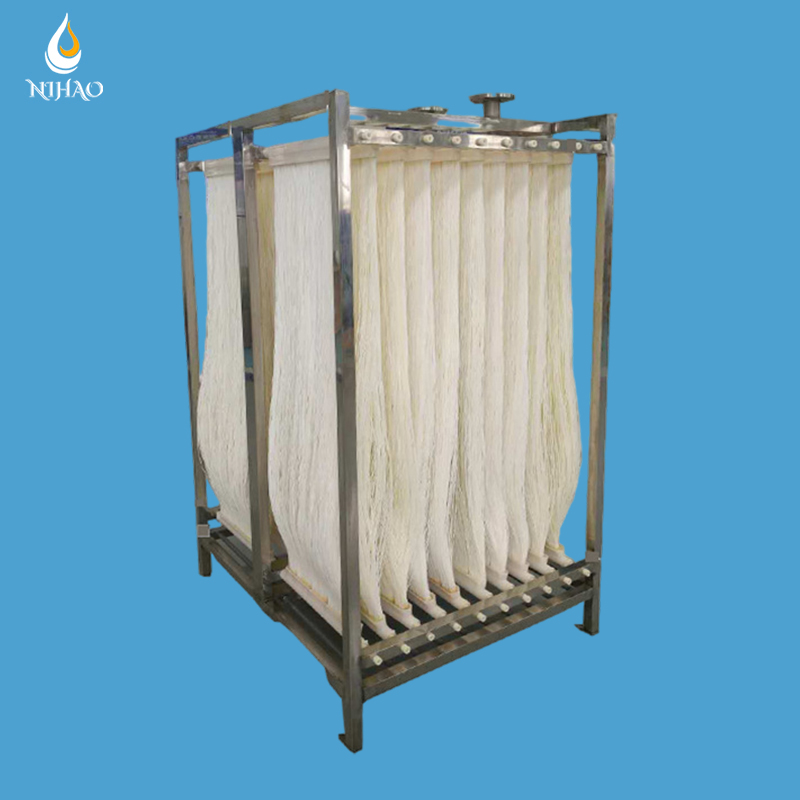 +86-15267462807
+86-15267462807
Membrane bioreactors (MBRs) are a type of wastewater treatment system that combines biological treatment with membrane filtration. MBRs are increasingly being used for a variety of applications, including municipal wastewater treatment, industrial wastewater treatment, and water reuse.
MBR membranes are the key component of MBR systems. They are responsible for separating the treated water from the mixed liquor in the MBR process. There are two main types of MBR membranes:
Organic membranes: These are the most common type of MBR membrane. They are made from polymers such as polyvinylidene fluoride (PVDF), polypropylene (PP), and polysulfone (PSf). Organic membranes are relatively low-cost and have good performance.
Inorganic membranes: These membranes are made from materials such as ceramic and metal. Inorganic membranes are more expensive than organic membranes, but they are more durable and have a longer lifespan.
Polyvinylidene fluoride (PVDF): PVDF is a popular choice for MBR membranes due to its excellent chemical resistance, high purity, thermal and mechanical strength, and good electrical insulating properties. It is a high-performance thermoplastic fluoropolymer, meaning it is a plastic formed from fluorine monomers.
Polypropylene (PP): PP is another cost-effective option with good chemical resistance. It is a thermoplastic polymer that is used in a variety of applications, including packaging, textiles, and automotive parts.
Polysulfone (PSf): PSf offers good performance and durability, but can be more expensive than PVDF. It is a thermoplastic polymer that is used in a variety of applications, including medical devices, food and beverage packaging, and water filtration membranes.
Ceramic membranes: Ceramic membranes are made from materials such as alumina, zirconia, and titania. They are highly durable and resistant to chemicals, but they are also the most expensive type of MBR membrane.
Metal membranes: Metal membranes are made from materials such as stainless steel and titanium. They are also highly durable and resistant to chemicals, but they are more expensive than ceramic membranes.
MBR systems typically consist of the following components:
Membrane tank: The membrane tank is where the MBR membranes are housed.
Mixed liquor tank: The mixed liquor tank is where the biological treatment process takes place.
Sludge return pump: The sludge return pump is used to return sludge from the membrane tank to the mixed liquor tank.
Permeate pump: The permeate pump is used to pump the treated water from the membrane tank.
MBRs are used for a variety of applications, including:
Municipal wastewater treatment: MBRs can be used to treat municipal wastewater to produce high-quality effluent that can be discharged to the environment or reused.
Industrial wastewater treatment: MBRs can be used to treat industrial wastewater from a variety of industries, including food and beverage, textile, and chemical.
Water reuse: MBRs can be used to produce high-quality water that can be reused for a variety of purposes, such as irrigation, toilet flushing, and industrial cooling.
MBRs offer a number of advantages over traditional wastewater treatment systems, including:
High-quality effluent: MBRs produce high-quality effluent that can be discharged to the environment or reused.
Small footprint: MBRs have a small footprint, making them ideal for use in space-constrained areas.
Low energy consumption: MBRs have low energy consumption, making them an energy-efficient option for wastewater treatment.
Easy operation: MBRs are easy to operate and maintain.
MBR membranes are available in a variety of configurations, including:
Hollow fiber membranes: These are the most common type of MBR membrane configuration. They are made up of a bundle of hollow fibers that are sealed at one end. The wastewater flows through the inside of the fibers, and the treated water is collected from the outside of the fibers.
Flat sheet membranes: These membranes are made up of flat sheets of material. The wastewater flows across the surface of the membranes, and the treated water is collected from the other side of the membranes.
Spiral wound membranes: These membranes are made up of a spiral-wound configuration. The wastewater flows between two sheets of membrane material, and the treated water is collected from the permeate channel.
MBR membranes are available with a variety of pore sizes, including:
Microfiltration (MF): MF membranes have a pore size of typically in the range of 0.1 to 10 micrometers. They are effective in removing suspended solids and some bacteria, but may not be suitable for all applications requiring high effluent quality.
Ultrafiltration (UF): UF membranes, commonly used in MBR applications, have a tighter pore size of 0.01 to 0.1 micrometers. They can remove not only suspended solids and bacteria but also macromolecules, viruses, and colloids, resulting in a higher quality effluent suitable for reuse or discharge with stricter regulations.
As mentioned earlier, ceramic membranes are a type of inorganic MBR membrane known for their:
High durability and chemical resistance: They can withstand harsh environments with a wide pH range (pH 0-14), high pressure (up to 10 MPa), and elevated temperatures (up to 350°C). This makes them suitable for treating high-concentration industrial wastewater containing strong chemicals.
High flux and lower energy consumption: Ceramic membranes often exhibit higher permeate flow rates (flux) compared to some organic membranes. This translates to potentially lower energy consumption for achieving the desired treatment capacity.
The selection of the most suitable MBR membrane depends on several factors, including:
Type of wastewater: The specific characteristics of the wastewater being treated, such as its composition, suspended solids content, and presence of contaminants, will influence the pore size and material requirements.
Desired effluent quality: The required level of effluent quality for reuse or discharge will determine the appropriate pore size and potentially the membrane material.
System operating cost: Organic membranes like PVDF and PP offer a balance between cost and performance, while ceramic membranes provide superior durability for challenging applications but come at a higher initial investment.
Project lifespan: The expected lifespan of the MBR system should be considered, with ceramic membranes often lasting longer than organic membranes.